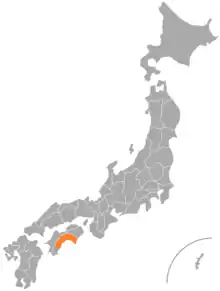Tosa dialect
The Tosa dialect (Japanese: 土佐弁 tosa-ben) is a Japanese Shikoku dialect spoken in central and eastern Kochi Prefecture (former Tosa Province), including Kochi City.
| Tosa dialect | |
|---|---|
| 土佐弁 | |
 Tosa dialect area. | |
| Native to | Japan |
| Region | Kōchi, Shikoku |
Japonic
| |
| Language codes | |
| ISO 639-3 | – |
jpn-koc | |
Classification
Shikoku dialects are divided into Western (Tokushima, Kagawa and Ehime), Southern (Kochi), and also occasionally Southwest (western Kochi and southern Ehime).[1][2] The Tosa dialect exists in a somewhat unique position due to being historically isolated from other prefectures because of the Shikoku Mountains.[1]
Kochi Prefecture dialects are broadly divided into Western and Eastern-Central.[3][4]
- Western dialect - Shimanto (city), Tosashimizu, Sukumo, Otsuki, Mihara, Kuroshio (excluding the former town of Saga), Shimanto (town) (excluding the former town of Kubokawa), Yusuhara.[3][4] Possesses a Tokyo standard pitch accent. Known as the 'Hata dialect’.
- Eastern-Central dialect - All other areas in Kochi. Possesses a Keihan standard, or Tarui standard pitch accent. Known as the 'Tosa dialect’, and will be described in this article.[2]
The coastal region from Muroto to Toyo has been influenced by the Tokushima Awa dialect and the Kinki dialects.[3][5]
Phonology
The most notable phonetic traits of the Tosa dialect are as follows:
- Virtually no silent vowels.
- The diphthong ei is distinctly retained.[5] For example: pronunciation of keisan (計算 calculation) in the Tosa dialect is keisan (ケイサン), as opposed to keesan (ケーサン) in standard Japanese and Kansai dialects.
- Among older speakers, a nasalised sound (n) is inserted before g and d.[3] Example: kagami (鏡 mirror) → kangami.[6]
- Older speakers also differentiate between ji (じ) and di (ぢ) and zu (ず) and du (づ) (so-called yotsugana). Ji is pronounced [ʒi] whilst di is pronounced [dʒi], zu is pronounced [zu] whilst dzu is pronounced [dzu].[6] In addition, tsu is sometimes pronounced tu.[7]
- Shi (し) sometimes becomes i (い) (i-euphony).[8] For example: doshita (どうした) → doita (どういた), soshite (そして) → soite (そいて) and ashita (あした) → aita (あいた).
- In other Shikoku dialects and in the Kinki dialects, single-mora words tend to become lengthened like in te (手) → tee (てー) or chi (血) → chii (ちー), but this tendency is weaker in the Tosa dialect.[8] Only third-class nouns such as ki (木) and te (手) are sometimes lengthened.[8] However, mainly among the younger generation, increased interaction with other Shikoku dialects and the Kinki dialects through media has resulted in a continuing trend of lengthening all single-mora words.
See also
References
- 土居, 重俊 (1982). 「四国方言の概説」、飯豊毅一; 日野資純; 佐藤亮一編 『講座方言学 8 中国・四国地方の方言』 (in Japanese). 国書刊行会. p. 271.
- 吉田, 則夫 (1982). 「高知県の方言」、飯豊毅一; 日野資純; 佐藤亮一編 『講座方言学 8 中国・四国地方の方言』 (in Japanese). 国書刊行会. p. 429.
- 土居, 重俊 (1982). 「四国方言の概説」、飯豊毅一; 日野資純; 佐藤亮一編 『講座方言学 8 中国・四国地方の方言』 (in Japanese). 国書刊行会. p. 291.
- 吉田, 則夫 (1982). 「高知県の方言」、飯豊毅一; 日野資純; 佐藤亮一編 『講座方言学 8 中国・四国地方の方言』 (in Japanese). 国書刊行会. pp. 428–429.
- 吉田, 則夫 (1982). 「高知県の方言」、飯豊毅一; 日野資純; 佐藤亮一編 『講座方言学 8 中国・四国地方の方言』 (in Japanese). 国書刊行会. p. 430.
- 吉田, 則夫 (1982). 「高知県の方言」、飯豊毅一; 日野資純; 佐藤亮一編 『講座方言学 8 中国・四国地方の方言』 (in Japanese). 国書刊行会. pp. 430–431.
- 吉田, 則夫 (1982). 「高知県の方言」、飯豊毅一; 日野資純; 佐藤亮一編 『講座方言学 8 中国・四国地方の方言』 (in Japanese). 国書刊行会. p. 431.
- 吉田, 則夫 (1982). 「高知県の方言」、飯豊毅一; 日野資純; 佐藤亮一編 『講座方言学 8 中国・四国地方の方言』 (in Japanese). 国書刊行会. p. 432.
This article is issued from Wikipedia. The text is licensed under Creative Commons - Attribution - Sharealike. Additional terms may apply for the media files.